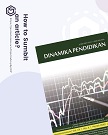Entrepreneurial Intention Model of Learning and Self-Efficacy Aspects
(1) Indonesia of Education University
(2) Indonesia of Education University
(3) Indonesia of Education University
Abstract
The purpose of this study is to unearth the effect of entrepreneurship learning on entrepreneurial intentions mediated by self-efficacy, and to find out the differences in entrepreneurial intentions viewed from the gender aspect. The research method employed in this study was an explanatory survey method. With respect to the research population, 560 accounting education students from all over Indonesia took part in this study by using the sample size technique of Isaac Michael so that the sample size was 233 respondents. The research samples taken from the population of accounting education students in Indonesia consisted of the students from Unimed, UPI, UNY, UNM, UM Malang and Unesa Surabaya. The data were collected using questionnaires in a google form and the validity and reliability of the collected data had also been tested. In this study, descriptive analysis and path analysis were employed as the data processing technique. The results showed that entrepreneurship learning and self-efficacy had a significant positive effect on entrepreneurial intentions. In particular, self-efficacy had the greatest effect on entrepreneurial intentions. There is no difference in entrepreneurial intentions based on the gender aspect. It is recommended to increase entrepreneurship learning through facilities and infrastructure indicators, self-efficacy through generally indicators, and entrepreneurial intentions through the indicators of spirit to try entrepreneurship.
Keywords
Full Text:
PDFReferences
Ahmed, I., Nawaz, M. M., Ahmad, Z., Shaukat, M. Z., Usman, A., Wasim-ul-Rehman, & Ahmed, N. (2010). Determinants of students’ entrepreneurial career intentions: Evidence from business graduates. European Journal of Social Sciences, 15(2), 14–22.
Ajzen, I cek. (1991). Attitudes, personality and behavior. Open University Press.
Ajzen, I cek. (2005). Attitude, Personality and Behavior (Second Edi). Mc Graww Hill.
Ajzen, Icek. (2002). Perceived Behavioral Control, Self-Efficacy, Locus of Control, and The Theory of Planned Behavior (50th ed.). Organizational Behavior and Human Decission Processes.
Alma, B. (2013). Kewirausahaan. Alfa Beta.
Anggraeni, D., & Nurcaya, I. (2016). Peran Efikasi Diri Dalam Memediasi Pengaruh Pendidikan Kewirausahaan Terhadap Niat Berwirausaha. E-Jurnal Manajemen Universitas Udayana, 5(4), 241653.
Badan Pusat Statistik. (2019). Tingkat Pengangguran Terbuka. [Online]. Tersedia: https://bps.go.id. [16 November 2020
Bandura. (1997). Self-Efficacy: The Exercise of Control. W.H. Freeman and Company.
Barbuto, J. E., L., B., & La Rey, P. (2003). Predicting Entrepreneurial Success in the Post Apartheid Era. Journal of Entrepreneurship, 13, 53–68.
Boissin, J.-P. e t. al. . (2009). Student and entrepreneurship ; a comparative study of france and the United states. Journal of Small Business and Entrepreneurship, vol 22.
Boyd, N. G., & Vozikis, G. S. (1994). The Influence of Self-Efficacy on the Development of Entrepreneurial Intentions and Actions. Entrepreneurship Theory and Practice, 18(4), 63–77. https://doi.org/10.1177/104225879401800404
Carr, J. C., & Sequeira, J. M. (2007). Prior family business exposure as intergenerational influence and entrepreneurial intent: A Theory of Planned Behavior approach. Journal of Business Research, 60(10), 1090–1098. https://doi.org/10.1016/j.jbusres.2006.12.016
Charney, A., Libecap, G. D., & Center, K. E. (2000). The Impact of Entrepreneurship Education: An Evaluation of the Berger Entrepreneurship Program at the. 1985–1999.
Crant, J. (1996). The proactive personality scale as a predictor of entrepreneurial intentions. Journal of Small Business Management, 34(3), 42.
Cromie, S. (2000). ssessing entrepreneurial inclinations: some approaches and empirical evidenceâ€. European Journal of Work and Organizational Psychology, 9 (1).
Anda, L. P., & Anderson, R. B. (2007). International handbook of research on indigenous entrepreneurship. International Handbook of Research on Indigenous Entrepreneurship. https://doi.org/10.4337/9781781952641
Anduhadimedjo.R, D. (2010). Kewiraswastaan and Pembangunan. Alfa Beta.
DeTienne, D.R. and Chandler, G. N. (2004). Opportunity identification and its role in the entrepreneurialclassroom: a pedagogical approach and empirical testâ€,. Academy of Management Learning and Education, Vol. 3 No., 242–257.
Do Paço, A.M.F., Ferreira, J.M., Raposo, M., Rodrigues, R.G. and Dinis, A. (2011). Behaviours andentrepreneurial intention: empiricalfindings about secondary studentsâ€. Journal of International Entrepreneurship, 9 No 1, 20–38.
Drucker, P. F. (1985). Inovasi and Kewirausahaan. Penerbit Erlangga.
Eksi, & Novi. (2020). Terhadap Minat Berwirausaha yang Dimoderasi Oleh Efikasi Diri pada Siswa Kelas Xi Bdp Smkn 2 Kediri Eksi Sekarini Novi Marlena. 08(01), 674–680.
Farashah, A. D. (2013). The process of impact of entrepreneurship education and training on entrepreneurship perception and intention: Study of educational system of Iran. Education and Training, 55(8–9), 868–885. https://doi.org/10.1108/ET-04-2013-0053
Galloway, L., & Brown, W. (2002). Entrepreneurship education at university: a driver in the creationof high growthfirms?â€. Education Training, 44 Nos 8/9, 398-405.
Hutasuhut, S. (2018). The roles of entrepreneurship knowledge, self-efficacy, family, education, and gender on entrepreneurial intention. Dinamika Pendidikan, 13(1), 90-105.
Indarti, N., & Rostiani. (2008). Intensi Kewirausahaan Mahasiswa: Studi Perbandingan Antara Indonesia, Jepang And Norwegia. Jurnal Ekonomi & Bisnis Indonesia (Fakultas Ekonomi And Bisnis Universitas Gadjah Mada), 23(4), 369–384. https://doi.org/10.22146/jieb.6316
Kolvereid, L. (1996). Prediction of employment status choice intentions.Entrepreneurship: Theory and Practice, 20(3), 45–57.
Kolvereid, & Moen. (1997). Kolvereid Moen1997.pdf. Jurnal of European Industrial Training, 21/4(entrepreneurship), 154.
Kourilsky, M., & Walstad, W. (1998). Entrepreneurship and female youth: Knowledge, attitudes, gender differences, andeducational practices. Journal of Business Venturing, 13(1), 77–88.
Kristiansen, S., & Indarti, N. (2004). Entrepreneurial intention among Indonesian and Norwegian students. Journal of Enterprising Culture, 12(01), 55–78.
Krueger, N.F. and Dickson, P. . (1994). How believing in ourselves increases risk taking: perceivedself-efficacy and opportunity recognitionâ€,. Decision Sciences, Vol 25 No, 385–400.
Kuehn, K. W. (2008). Entrepreneurial intentions research: implications for entrepreneurship educationâ€,. Journal of Entrepreneurship Education, 11, 87–98.
Kusnendi. (2005). Analisis Jalur Konsep and Aplikasi Program SPSS. Universitas Pendidikan Indonesia.
Lans, T., Gulikers, J., & Batterink, M. (2010). Moving beyond traditional measures of entrepreneurial intentions in a study among life-sciences students in the Netherlands. Research in Post-Compulsory Education, 15(3), 259–274. https://doi.org/10.1080/13596748.2010.503997
Liñán, F., RodrÃguez-Cohard, J. C., & Rueda-Cantuche, J. M. (2011). Factors affecting entrepreneurial intention levels: A role for education. International Entrepreneurship and Management Journal, 7(2), 195–218. https://doi.org/10.1007/s11365-010-0154-z
Mc Gee, J.E., Peterson, M. and Mueller, S. L. (2009). Entrepreneurial self-efficacy: refining the measureâ€,. Entrepreneurship Theory and Practice, Vol. 33 No, 965–988.
Mentoor, E. R., & Friedrich, C. (2007). Is Entrepreneurial Education at South African Universities Successful?: An Empirical Example. Industry and Higher Education, 21(3), 221–232. https://doi.org/10.5367/000000007781236862
Niu, H. (2010). Erratum to & ldquo; Investigating the effects of self-efficacy on food service industry employees & rsquo; career commitment. International Journal of Hospitality Management, 29.
Oktaviana, V. D., Umami, N., & Program, E. E. (2018). Pengaruh efikasi diri and kreativitas terhadap intensi berwirausaha pada siswa kelas xi smk negeri 1 pogalan tahun ajaran 2017/2018. 11(2), 80–88.
Oosterbeek, H., van Praag, M., & IJsselstein, A. (2012). The Impact of Entrepreneurship Education on Entrepreneurship Competencies and Intentions: An Evaluation of the Junior Achievement Student Mini-Company Program. SSRN Electronic Journal. https://doi.org/10.2139/ssrn.1118251
Ormrod, J. E. (2008). Psikologi Pendidikan (Jilid 1). Penerbit Erlangga.
Peterman, N. E., & Kennedy, J. (2003). Enterprise Education: Influencing Students’ Perceptions of Entrepreneurship. Entrepreneurship Theory and Practice, 28(2), 129–144. https://doi.org/10.1046/j.1540-6520.2003.00035.x
Phan, P., Wong, P., & Wang, C. (2002). Antecedents to entrepreneurship among university students in Singapore:Beliefs, attitudes and background. Journal of Enterprising Culture, 10(02), 151–174.
Puspitaningsih, F. (2016). Pengaruh Pendidikan Kewirausahaan dan Lingkungan Keluarga Terhadap Minat Wirausaha dengan Self Efficacysebagai Variable Intervening Padamahasiswa STKIP PGRI Trenggalek. Dewantara, 2(1), 71–84.
Sesen, H. (2013). Personality or environment? A comprehensive study on the entrepreneurial intentions of university students. Education + Training, 55(7), 624–640. https://doi.org/10.1108/ET-05-2012-0059
Setiawan, J. L. (2014). Examining entrepreneurial self-efficacy among students. Procedia–Social and Behavioral Sciences, pp. 235-24.
Shane, S., Locke, E. A., & Collins, C. J. (2003). Entrepreneurial Motivation Objectives. Entrepreneurial and Small Business Operations Commons. http://digitalcommons.ilr.cornell.edu/articles
Slameto. (2010). Belajar and Faktor Pengaruhnya. Rineka Karya.
Smith, R., Sardeshmukh, S., & Combs, G. (2016). Understanding gender, creativity, and entrepreneurial intentions. Education+ Training, 58(3), 263–282.
Souitaris, V., Zerbinati, S., & Al-Laham, A. (2007). Do entrepreneurship programmes raise entrepreneurial intention of science and engineering students? The effect of learning, inspiration and resources. Journal of Business Venturing, 22(4), 566–591. https://doi.org/10.1016/j.jbusvent.2006.05.002
Sugiyono. (2004). Metodologi Penelitian Administrasi, (Edisi keli). Alfa Beta.
Suherman, E. (2010). Desain Pembelajaran Kewirausahaan. Alfa Beta.
Thompson, E. R. (2009). Entrepreneurial Intent : and Development Reliable Metric. Entrepreneurship: Theory and Practice, 33(0), 669–695. http://papers.ssrn.com/sol3/papers.cfm?abstract_id=1396451
Tung, L. C. (2011). The Impact of Entrepreneurship Education on Entrepreneurial Intention of Engineering Students. 11(1), 67–86.
Wibowo, M. (2011). Pembelajaran Kewirausahaan dan Minat Wirausaha Lulusan SMK. Eksplanasi, 6 Nomor 2(2), 109–122. https://doi.org/10.31932/ve.v8i2.42
Wijaya, T. (2007). Hubungan Adversity Intelligence Dengan Intensi Berwirausaha (Studi Empiris Pada Siswa Smkn 7 Yogyakarta). Hubungan Adversity Intelligence Dengan Intensi Berwirausaha (Studi Empiris Pada Siswa Smkn 7 Yogyakarta), 9(2), 117–127. https://doi.org/10.9744/jmk.9.2.pp.117-127
Wilson, F., Kickul, J., & Marlino, D. (2007). Gender, entrepreneurial self-efficacy, and entrepreneurial career intentions: Implications for entrepreneurship education. Entrepreneurship: Theory and Practice, 31(3), 387–406. https://doi.org/10.1111/j.1540-6520.2007.00179.x
Zahra, S. A., Kuratko, D. F., & Jennings, D. F. (1999). Guest Editorial: Corporate Entrepreneurship and Wealth Creation: Contemporary and Emerging Perspectives. Entrepreneurship Theory and Practice, 24(2), 5–8. https://doi.org/10.1177/104225879902400201
Zhao, H., Hills, G. E., & Seibert, S. E. (2005). The mediating role of self-efficacy in the development of entrepreneurial intentions. Journal of Applied Psychology, 90(6), 1265–1272. https://doi.org/10.1037/0021-9010.90.6.1265
Refbacks
- There are currently no refbacks.

This work is licensed under a Creative Commons Attribution 4.0 International License.

.png)

.png)





